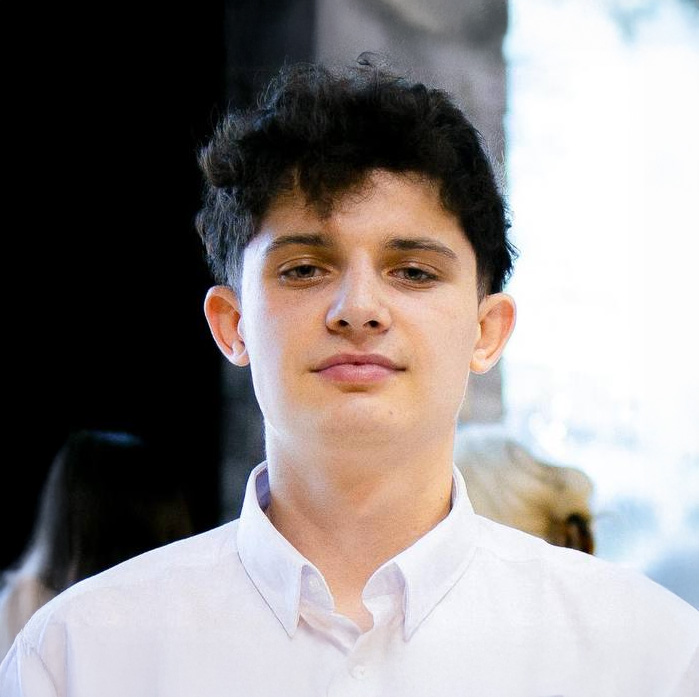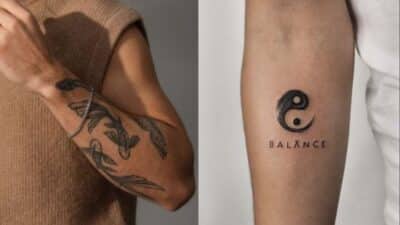Geometric tattoos are a popular style of body art that focus on the use of precise shapes such as circles, triangles, and squares to create visually striking designs. These tattoos stand out for their clean lines and mathematical patterns, often carrying symbolic meanings or personal significance for those who wear them. Whether you’re drawn to the aesthetics or the deeper symbolism, geometric tattoos offer a versatile option for self-expression.
You’ll notice that geometric tattoo designs can range from simple patterns to complex compositions that blend abstract imagery with realism. This style appeals to many people because of its structured look and the opportunity to personalize each piece, making every tattoo unique to its wearer.
Key Takeaways
- Geometric tattoos are defined by the use of precise, often symmetrical shapes.
- Designs can be customized with personal meaning or symbolism.
- Choosing a skilled artist ensures the crisp lines and planned details of this style.

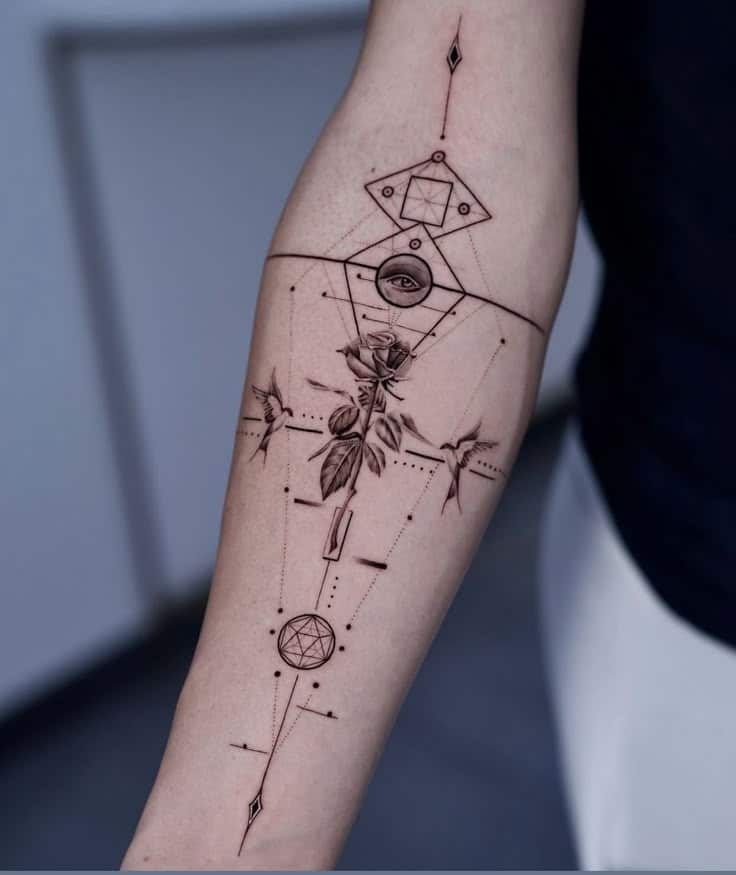
What Are Geometric Tattoos?
Geometric tattoos use lines, shapes, and patterns to create both abstract and representational designs on your skin. These tattoos often carry symbolic meanings, incorporate symmetry, and showcase artistry through simplicity or complexity.
Origins and History
Geometric tattooing has deep historical roots, appearing in ancient cultures around the world. Early examples include tribal tattoos from Polynesia, where repeated patterns and symmetrical designs symbolized identity and social status.
Ancient Egyptians used geometric patterns in both art and body markings, often associating the shapes with spiritual meanings. For example, the triangle has been seen as a symbol of change or strength. In Eastern traditions, mandalas and other repeating geometric motifs have represented balance and harmony.
Geometric tattoos have evolved over time, blending traditional methods with modern tattooing technology. Today, artists may draw inspiration not only from ancient symbols but also from mathematical concepts or architectural forms.
Defining Characteristics
Geometric tattoos rely on basic shapes like circles, triangles, squares, and polygons. These elements are often repeated, mirrored, or layered to build intricate patterns, resulting in a visually striking composition.
A key feature is symmetry—many designs focus on balance and precision. Straight lines, clean curves, and sharp points are frequent components. Some geometric tattoos also use negative space or dotwork techniques to add depth and texture.
Unlike illustrative tattoos that depict lifelike images, geometric tattoo designs typically use abstraction and stylization. This gives you the flexibility to choose a design for visual appeal or personal significance, such as representing order, balance, or interconnectedness.
Popular Geometric Tattoo Styles
There are several common styles within geometric tattoos, each offering a unique look:
- Mandalas: Circular designs with radiating patterns, often used to symbolize unity and wholeness.
- Sacred geometry: Incorporates motifs like the Flower of Life, Metatron’s Cube, or Platonic solids to suggest universal truths or mathematical harmony.
- Polygonal animals: Forms animals using angular shapes and straight lines, offering a modern interpretation of classic imagery.
Some tattoos blend geometric elements with realism, like a portrait partially made from geometric shapes. Patterns can be minimalist or highly detailed, allowing you to choose a style that matches your personality or meaning you wish to convey. Bold black ink is common, but colored geometric tattoos are also popular.
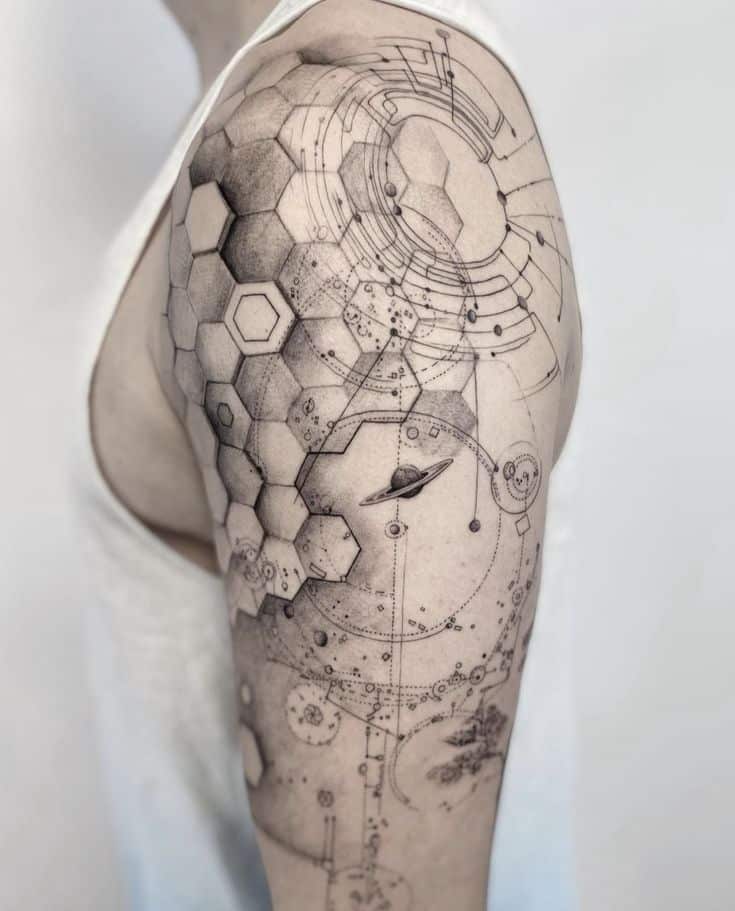

Core Design Elements in Geometric Tattoos
Geometric tattoos are built on precise lines, repeatable patterns, and carefully chosen symbols. These designs combine artistic intention with mathematical structure, resulting in tattoos that express deep meaning as well as visual appeal.
Sacred Geometry and Symbolism
Sacred geometry plays a key role in many geometric tattoos. You will often encounter patterns like the Flower of Life, mandalas, or interlocking circles and shapes known for their use in spiritual and religious contexts.
These designs are not just ornamental—they represent concepts such as unity, interconnectedness, and the universe’s underlying order. Mandalas embody the idea of balance, while fractals and repeating motifs point to infinite complexity found in nature.
When you choose a tattoo rooted in sacred geometry, it often stands for harmony between mind, body, and spirit. Commonly, these tattoos serve as personal reminders of growth or a desire for spiritual connection.
Shapes and Motifs: Triangles, Circles, Squares, Hexagons
Specific geometric shapes each carry distinct meanings:
- Triangles are often associated with strength, change, and direction.
- Circles suggest wholeness, eternity, and cycles.
- Squares convey stability and a sense of grounding.
- Hexagons, seen in honeycombs and the Flower of Life, represent harmony and structure—highlighting nature’s mathematical consistency.
Motifs like mandalas or the Flower of Life combine these shapes to create visually complex designs. Using multiple shapes together helps you tell a unique story, often blending cultural, mathematical, and personal themes.
A simple geometric tattoo may focus on a single motif, while more intricate pieces integrate several shapes for additional depth and meaning.
Symmetry, Balance, and Harmony
Symmetry is one of the most defining features of geometric tattoos. You notice it in repeating patterns, mirrored shapes, and the overall layout of the tattoo on your skin.
This focus on balance is not only visual—it also symbolizes inner harmony and order. Many geometric tattoos are designed to evoke a sense of unity by aligning patterns evenly on both sides of a central axis.
Harmony in these tattoos comes from careful spacing, repetition, and consistency in line work. The result is a tattoo that — much like elements in nature — appears both organized and complete.


Techniques and Style Variations
Geometric tattoos depend on meticulous techniques, such as precise linework and carefully executed shading. The most common styles in this genre are built on accuracy, repetition, and the interplay of simplicity with detail.
Linework and Precision
Clean linework is the foundation of most geometric tattoos. Artists use single-needle or fine-line machines to create sharp, consistent lines. Your tattoo’s symmetry and clarity will rely heavily on an artist’s steady hand and control, as any deviation can disrupt the entire design.
Precision is key when it comes to geometric patterns. Squares, triangles, and hexagons require exact spacing and perfectly straight lines to maintain balance. Most linework is done in black ink for maximum contrast and a crisp, graphic look.
To help with accuracy, many artists use stencils or rulers during the initial placement. Consistency throughout the pattern is vital, especially in visuals inspired by mathematical or natural motifs. You often see this technique in sleeve work, mandalas, and minimalist tattoos.
Dotwork and Shading
Dotwork is another signature technique often used in geometric tattoos. It involves applying small dots in varying densities to build shading, gradients, or textures within shapes. This approach produces smooth transitions and allows for detailed, subtle effects without traditional solid fills.
Dotwork shading creates a softer, sometimes more intricate effect than flat colors. Your artist might use dotwork to highlight certain areas, emphasize three-dimensional forms, or add depth to patterns. This method also minimizes skin trauma since less ink is deposited at once.
Most dotwork is executed with black or dark gray inks, focusing on contrast between lighter and darker areas. This enhances the tattoo’s geometry and makes each section stand out. The result is a tattoo that balances bold structure and refined detail.


Meaning and Personalization
Geometric tattoos often hold complex meanings, combining visual appeal with personal symbolism. Their flexible designs allow you to express unique ideas while achieving a look that fits your style and values.
Personal Significance and Storytelling
A geometric tattoo can represent your beliefs, experiences, or goals. Each shape carries distinct meanings. For example:
- Triangles: Power, balance, and change
- Lines: Journey, purpose, or flexibility
- Circles: Wholeness, unity, or cycles
Choosing a shape or pattern lets you tell a story in a clear yet subtle way. You might select straight lines to symbolize discipline or integrate interlocking patterns to mark connected relationships.
If you want a lasting reminder of a major life event, geometric forms offer concise symbolism. Many people combine traditional motifs with geometric shapes for a design that feels both personal and classic.
Customization and Visual Appeal
Customization is key to the popularity of geometric tattoos. You can select patterns, line thickness, symmetry, and shading to create a look that matches your preferences. This versatility makes it easier to design a tattoo that is both visually striking and uniquely yours.
Common approaches include:
| Design Element | Options |
|---|---|
| Shapes | Triangles, circles, cubes |
| Line Styles | Bold, fine, dotted |
| Layout | Symmetrical, abstract |
| Color | Blackwork, colored ink |
Visual appeal comes from the precise arrangement of shapes and patterns. You can opt for simple outlines, intricate mandalas, or minimalist linework. Each choice customizes the tattoo’s look while incorporating personal meaning.


Choosing a Tattoo Artist and Aftercare
Finding the right artist for geometric tattoos and following proper aftercare practices are essential for long-lasting, sharp results. Clean techniques, style expertise, and responsible healing all play a role in a successful tattoo experience.
Selecting the Right Tattoo Artist
Choose an artist who specializes in geometric tattoos, as this style demands accuracy, symmetry, and a careful attention to detail. Review portfolios closely. Look for even lines, consistent patterns, and healed work that matches what you want.
Always visit studios in person when possible. Hygiene matters—ensure the environment is sterile, needles are single-use, and all surfaces are properly disinfected. Ask about their safety protocols and observe their setup. Reputable artists will answer questions openly and let you see how they work.
Compatibility is important. Discuss your ideas, any reference images, and be sure you understand each other. Good artists clearly communicate what’s possible and offer design adjustments when needed.

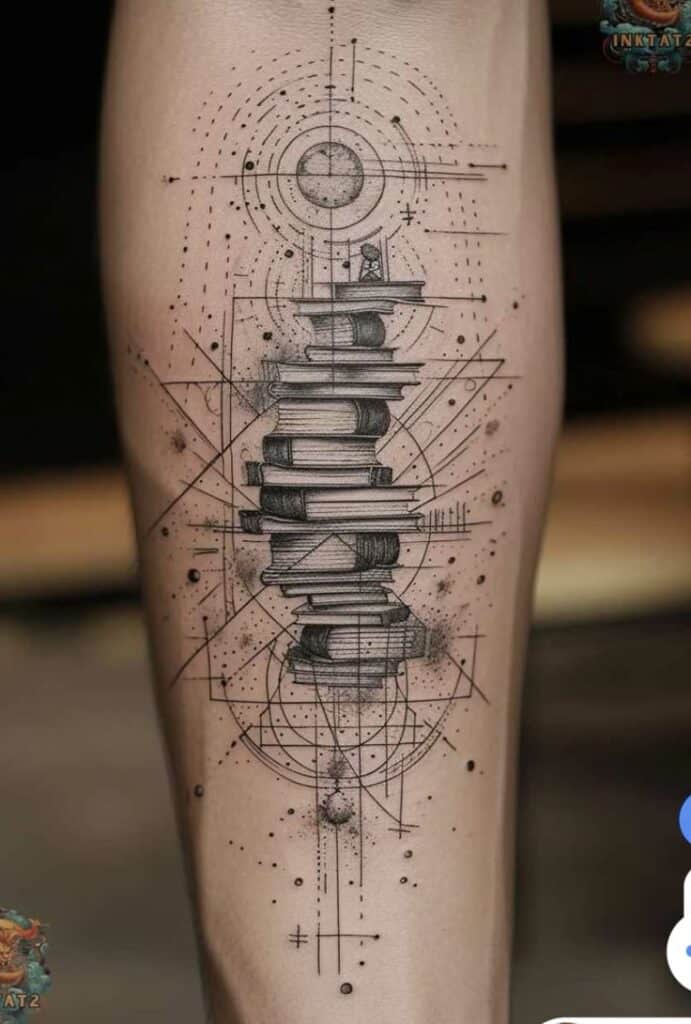
Tips for Tattoo Enthusiasts
Aftercare is just as important as your artist’s skills. Plan to follow the detailed instructions your artist provides. Usually, you’ll need to:
- Keep the tattoo clean and dry at first
- Apply a thin layer of healing ointment, as directed
- Avoid direct sun, soaking, and scratching the tattoo
Monitor the area for unusual redness, swelling, or discharge. Reach out to your artist if you notice signs of infection. Healing typically takes 2–4 weeks; proper care prevents fading or distortion.
Quick Reference: Geometric Tattoo Aftercare
| Step | Action |
|---|---|
| Cleanliness | Gently wash daily |
| Moisturize | Use fragrance-free |
| Sun Protection | Cover and avoid sun |
Following these steps helps geometric tattoos heal sharply and maintain crisp linework. Always stay in touch with your artist for guidance if you have questions during healing.
- 153shares
- Facebook0
- Pinterest153
- Twitter0
